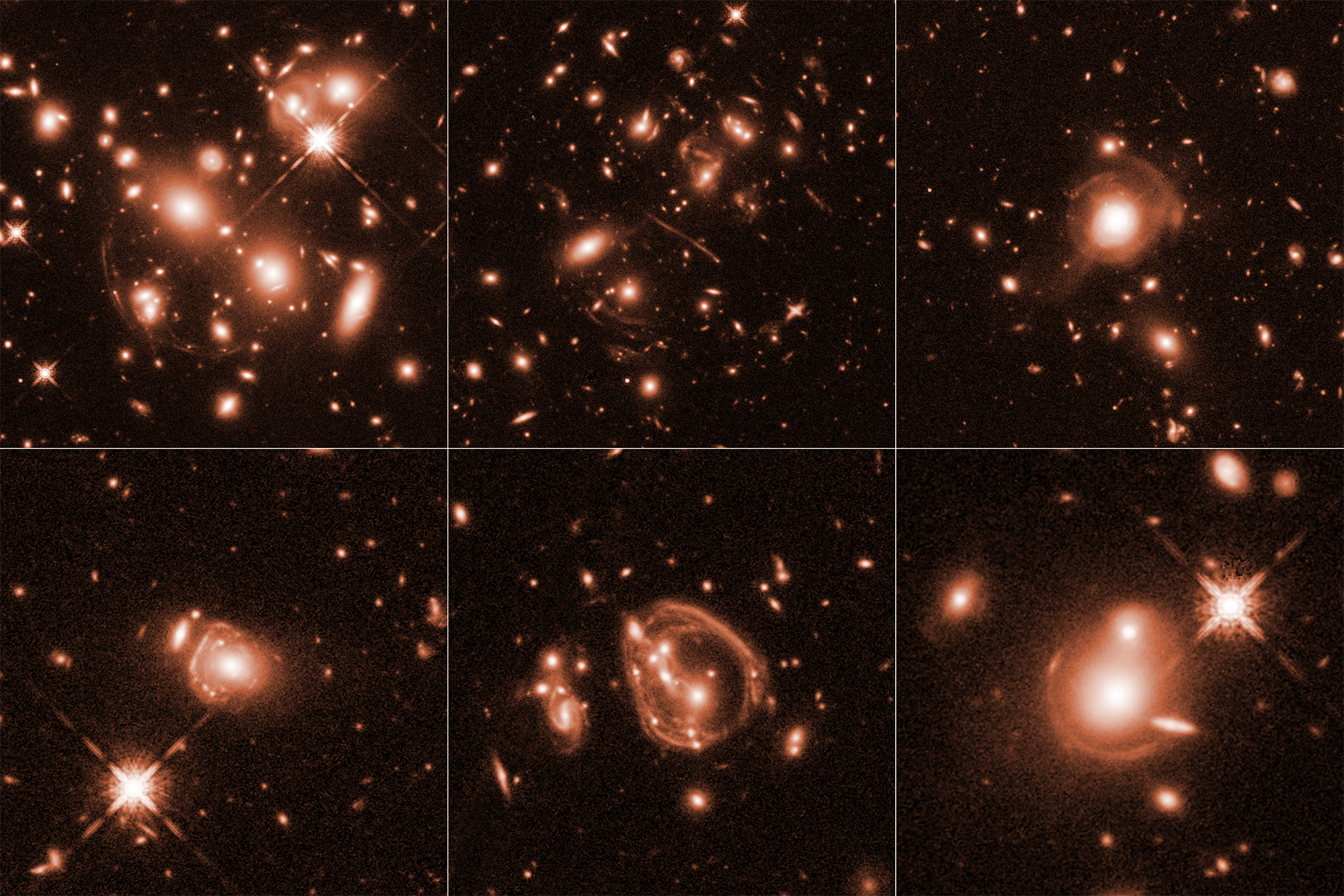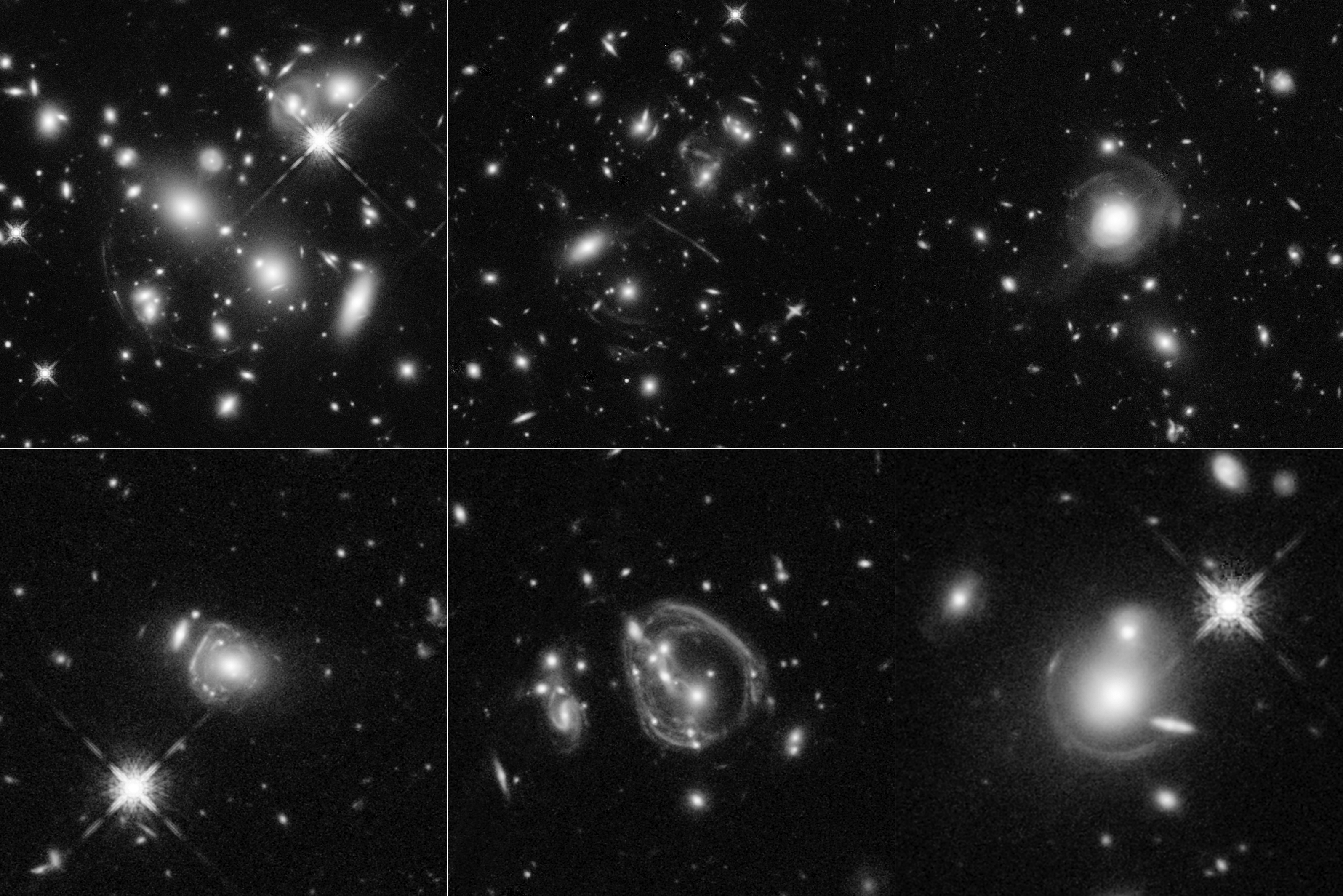Hubble Hits Jackpot: Images Capture Ultrabright Galaxies via Cosmic Magnification

A glittering jackpot of ultrabright galaxies bursting with star formation has been revealed in a series of stunning images taken by the Hubble Space Telescope.
The galaxies captured in these images sparkle like jewels of cosmic light. These massive collections of stars are each as much as 10,000 times more luminous than the Milky Way in the infrared range, or 10 trillion to 100 trillion times the brightness of the sun. They are also forming about 10,000 new stars each year, according to a statement from NASA. (By comparison, it is estimated that fewer than 10 stars form in the Milky Way each year.)
Viewers may also notice strange shapes, including rings and arcs of light. Those are mostly the result of a cosmic phenomenon known as gravitational lensing, in which a foreground galaxy acts as a lens, warping and magnifying the light from a more distant galaxy. [Gravitational Lensing Eloquently Described in 'Hubblecast' | Video]
This lensing has magnified the light from these very distant galaxies, giving scientists the opportunity to study in them in much finer detail than would be otherwise possible.
"These ultra-luminous, massive, starburst galaxies are very rare," James Lowenthal, an astronomy professor at Smith College in Massachusetts and lead researcher on the Hubble survey, said in the statement. "Gravitational lensing magnifies them so that you can see small details that otherwise are unimaginable. We can see features as small as about 100 light-years or less across. We want to understand what's powering these monsters, and gravitational lensing allows us to study them in greater detail."

The birth and death of so many stars generate a lot of new gas and dust, which obscures the galaxies in many wavelengths of light, including visible. But infrared light can penetrate those layers. These galaxies were first identified by the European Space Agency's Planck satellite, and were subject to further study by other instruments, but the Hubble observations confirmed that gravitational lensing is making them brighter and more visible.
The furious star formation in these galaxies coincides with the "peak of the universe's star-making boom between 8 billion and 11.5 billion years ago," according to the statement. Even so, only a few dozen of these star-forming, bright infrared galaxies existed in that period of the early universe, NASA said.
Get the Space.com Newsletter
Breaking space news, the latest updates on rocket launches, skywatching events and more!
In the nearby universe, researchers have identified so-called ultra-luminous infrared galaxies (ULIRGS), which are also massive, cloaked in dust, and have high rates of star formation. The star formation in those galaxies is "stoked by the merger of two spiral galaxies," according to the statement. Such a collision could have brought together large amounts of gas and dust into a relatively small region, creating an environment ripe for star formation.
But it's not clear if similar galaxy mergers were taking place between 11.5 billion and 8 billion years ago, so scientists aren’t sure if the galaxies seen in this recent Hubble survey are fueled by the same mechanism as the nearby galaxies.
"The early universe was denser, so maybe gas is raining down on the galaxies, or they are fed by some sort of channel or conduit, which we have not figured out yet," Lowenthal said. "This is what theoreticians struggle with: How do you get all the gas into a galaxy fast enough to make it happen?"
To unlock the mysteries these galaxies may hold, scientists need to know if the strange features that appear in the Hubble images — the curves and arcs of light — are artificial features generated by the lensing effect, or if they are indicative of actual features around the galaxies. The researchers now need to separate artifice from reality to come up with some answers.
Follow Calla Cofield @callacofield. Follow us @Spacedotcom, Facebook and Google+. Original article on Space.com.
Join our Space Forums to keep talking space on the latest missions, night sky and more! And if you have a news tip, correction or comment, let us know at: community@space.com.

Calla Cofield joined Space.com's crew in October 2014. She enjoys writing about black holes, exploding stars, ripples in space-time, science in comic books, and all the mysteries of the cosmos. Prior to joining Space.com Calla worked as a freelance writer, with her work appearing in APS News, Symmetry magazine, Scientific American, Nature News, Physics World, and others. From 2010 to 2014 she was a producer for The Physics Central Podcast. Previously, Calla worked at the American Museum of Natural History in New York City (hands down the best office building ever) and SLAC National Accelerator Laboratory in California. Calla studied physics at the University of Massachusetts, Amherst and is originally from Sandy, Utah. In 2018, Calla left Space.com to join NASA's Jet Propulsion Laboratory media team where she oversees astronomy, physics, exoplanets and the Cold Atom Lab mission. She has been underground at three of the largest particle accelerators in the world and would really like to know what the heck dark matter is. Contact Calla via: E-Mail – Twitter









